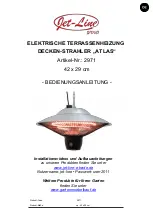
Mighty Max Volume Water Heater
Page 7
2G. Water System Piping
2G-1. Water Chemistry
Laars equipment is designed to be used in a
variety of water conditions. The water velocity in the
heat exchanger tubes is kept high enough to prevent
scaling from hard water, yet low enough to avoid
erosion by soft water. The water in 95 percent of the
urban centers in the United States is compatible with
this equipment, but in some areas a water supply will
contain a large quantity of scaling chemicals or the
water may be extremely soft or erosive. In rare
situations the water will contain both scaling
chemicals and erosive chemicals such as calcium or
sodium chloride. These conditions may be caused by
well water or a nearby pumping station, and the
particular condition may not be characteristic of the
entire city water system.
NOTE: It is possible to have hard and soft water
in the same city. Check with the local water company.
If an installer sees damage to any water handling
equipment at the installation site, it should be repaired
as soon as possible to help reduce maintenance costs.
If there is erosion, resize the pump to reduce water
velocity before the tube ruptures. If scaling is bad, set
up a heat exchanger tube-cleaning maintenance
schedule to prevent heat exchanger tube cracking and
wear. Not fixing the condition may cause serious
damage to the heater and the water system.
Scaling is a layer on the inner surface of the heat
exchanger tubes which restricts the flow of water.
Scale can be any color or texture, smooth or rough,
granular or amorphous. Erosion is usually identified
by pitting, cavitation, ridges and “islands” on the
inner surfaces of the heat exchanger tubes. If this is
caused by extremely soft water, or a water softener in
the system, the internal copper surfaces will be very
shiny. Other chemicals, such as chlorine or chlorides
in the water, will cause dark patches of erosion.
NOTE: Laars does not warrant heat exchangers
damaged by scaling, corrosion, or erosion.
2G-2. Water Piping
VW heaters are intended for heating large
volumes of water at constant flow rates, usually for
storage in a tank. Heaters in this type of application
are sometimes called circulating water heaters.
Figure 5 shows the VW heater with tank and two
pumps. One pump (recirculation) only circulates the
hot water through the building plumbing. The other
pump (heater) circulates water between the tank and
the heater. This heater circulating pump is essential
for proper operation of the heater (see Section 2G-5).
The heater circulating pump must be sized to
provide enough flow to prevent damage to the heat
exchanger, and must handle the hardness or softness
of the water being heated. Generally, hard water must
be pumped at higher velocity; however, soft water will
erode holes in the heat exchanger tubing if pumped
too fast.
The Mighty Max VW heater comes standard
with copper tubes, but in areas where the water supply
is soft or corrosive, the heat exchanger should be
factory ordered with cupronickel tubes. Consult the
local factory representative or Laars factory for
additional information.
2G-3. Pressure Buildup in Water System
The water utility supply meter may contain a
check valve, back flow preventer, or water pressure
reducing valve. This will create a closed water supply
system. Contact the water supplier or local plumbing
inspector on how to control this situation.
During the heating cycle of the heater, the water
expands creating a pressure buildup in the water
system. The pressure and temperature relief valve may
discharge hot water under these conditions, causing a
loss/waste of energy and a buildup of lime on the
relief valve seat.
NOTE: Do not plug the relief valve.
There are two methods to prevent the water
heater pressure relief valve from discharging hot
water in a closed water system:
1.
Install a pressure relief valve on the cold water
supply line. Make sure that the discharge of this
valve is directed to an open drain and protected
from freezing.
2.
Install a properly sized thermal expansion tank
on the cold water supply line.
2G-4. Temperature and Pressure Relief
Valve
For protection against excessive pressure, the
water heater is equipped with a pressure relief valve.
When the water heater is connected to a separate
storage vessel, a temperature and pressure relief valve
must be installed on the storage vessel. The
temperature and pressure relief valve must be design-
certified by a nationally recognized testing laboratory
that maintains periodic inspection of listed equipment
or materials, in accordance with the requirements for
Relief Valves and Automatic Gas Shutoff Devices for
Hot Water Supply Systems, ANSI Z21.22. (in Canada,
in accordance with the requirements for the Standard
for Temperature and Pressure Relief Valves and
Vacuum Relief Valves, CAN1-4.4).
The temperature and pressure relief valve must
have a BTU/h (kW) capacity rating that is greater than
the BTU/h (kW) input of the water heater. The
temperature and pressure relief valve must be marked
with a maximum working pressure not to exceed the
Содержание Mighty Max VW Series
Страница 25: ...Mighty Max Volume Water Heater Page 25 Figure 19 Troubleshooting Chart...
Страница 27: ...Mighty Max Volume Water Heater Page 27 Front View Right Side View...
Страница 28: ...Page 28 LAARS HEATING SYSTEMS Front View Rear View Right Side View Left Side View...
Страница 31: ...Mighty Max Volume Water Heater Page 31...








































